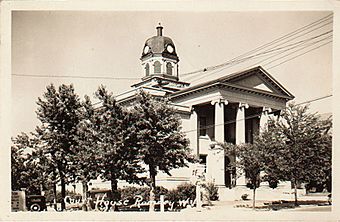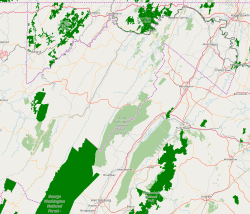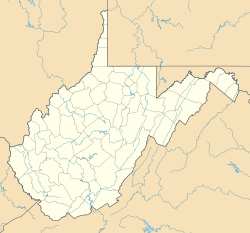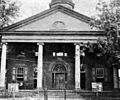Hampshire County Courthouse (West Virginia) facts for kids
Quick facts for kids |
|
|
Hampshire County Courthouse
|
|

Hampshire County Courthouse shortly after its construction, 1920s
|
|
| Location | 66 North High Street, Romney, West Virginia |
|---|---|
| Area | less than one acre |
| Built | 1922 |
| Architect | Holmboe & Pogue |
| Architectural style | Neoclassical Revival |
| MPS | County Courthouses of West Virginia MPS |
| NRHP reference No. | 05001006 |
| Added to NRHP | September 7, 2005 |
The Hampshire County Courthouse is an important building in downtown Romney. Romney is the main town, or county seat, of Hampshire County. This courthouse was built in 1922. It replaced an older courthouse from 1833 that burned down in 1921. The bell you see in the tall tower today is the original bell from that very first courthouse! The building has a classic style called Neoclassical.
Contents
Saving Records During the Civil War
During the Civil War, the courthouse in Hampshire County faced many challenges. From 1861 to 1864, no court meetings were held here. Union soldiers even used the building as a stable for their horses!
John Baker White's Quick Thinking
John Baker White was the Clerk of Court at the time. This means he was in charge of keeping all the county's important papers and records safe. He worried about the records being destroyed. So, he decided to move some of them to a safer place.
He loaded the most important books onto wagons. These books included records of land ownership (called deed books), wills (papers about what happens to someone's property after they die), and settlements of estates (records about how a person's belongings were divided). He sent these books to Winchester for safekeeping.
White was very smart. He only moved the bound books, which were like thick, heavy notebooks. He left the loose papers behind in the courthouse. This way, if one set of records was destroyed, the other might still survive. The loose papers were harder to move and keep together.
A Journey for Safety
In 1863, Winchester was no longer safe. Union Army forces were getting closer. So, White's son, Captain Christian Streit White, took over the job of protecting the records. He moved them again, this time to Front Royal.
But Front Royal also became dangerous. Captain White then moved the records to Luray Caverns, a large cave system. They stayed there for several months, hidden away.
In the fall of 1864, the records were in danger once more. Union Army troops were trying to destroy them. Captain White and his company quickly loaded about 150 record books into a wagon. They took them all the way to North Carolina, where they stayed safe until the war ended.
Records Returned Home
After the Civil War finished, Hampshire County's land records were returned to the courthouse. They were likely brought back by a soldier returning home from North Carolina. Thanks to John Baker White's careful planning, these important records survived. If he hadn't separated them, Hampshire County would have lost all its history from that time. The records left in the courthouse were indeed destroyed.
Other Interesting Facts
The original iron fence that stood around the 1833 courthouse was moved when the new building was constructed. You can now find it at the Hiett Graveyard. This graveyard is located on North River, between the towns of North River Mills and Pleasant Dale.
Gallery







